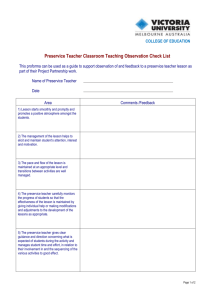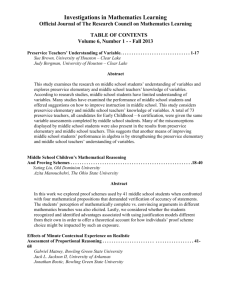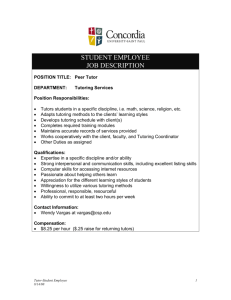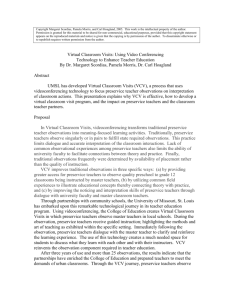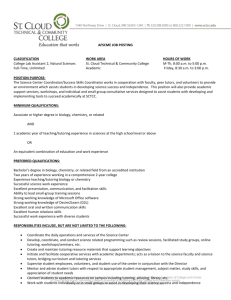Ellie
advertisement
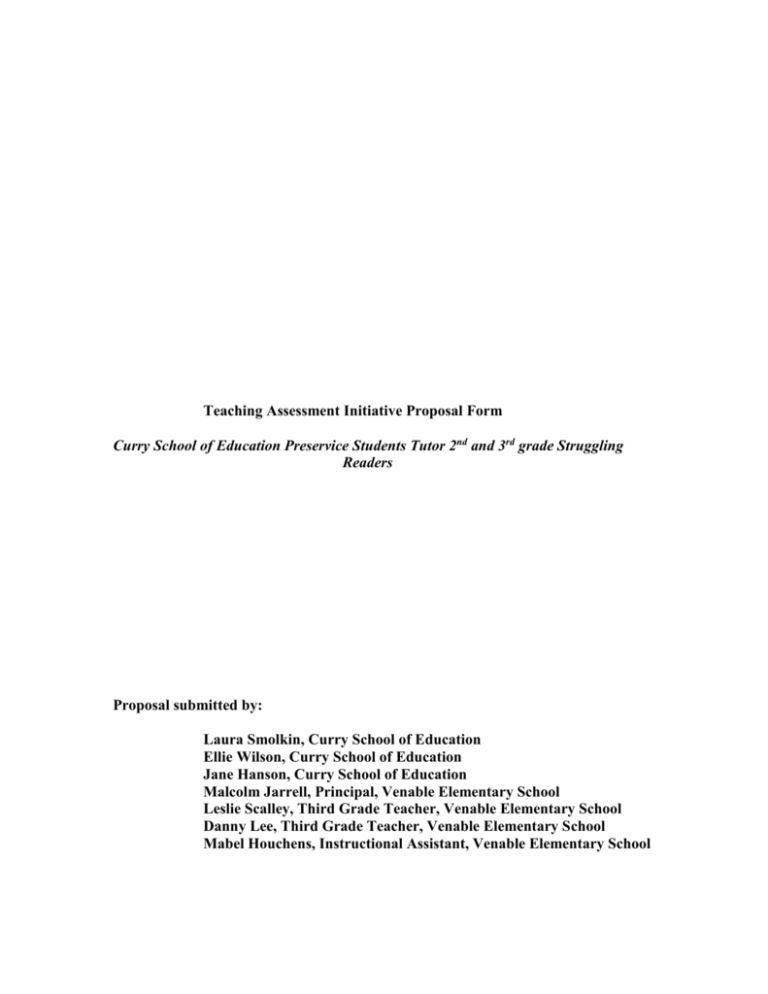
Teaching Assessment Initiative Proposal Form Curry School of Education Preservice Students Tutor 2nd and 3rd grade Struggling Readers Proposal submitted by: Laura Smolkin, Curry School of Education Ellie Wilson, Curry School of Education Jane Hanson, Curry School of Education Malcolm Jarrell, Principal, Venable Elementary School Leslie Scalley, Third Grade Teacher, Venable Elementary School Danny Lee, Third Grade Teacher, Venable Elementary School Mabel Houchens, Instructional Assistant, Venable Elementary School Teaching Assessment Initiative Proposal Form Curry School of Education Preservice Students Tutor 2nd and 3rd grade Struggling Readers 1. Problem statement/ Purpose of research Recent research conducted by the International Reading Association has noted that field experiences are a critical part of solid preservice preparation for the teaching of reading. The purpose of this particular research is to consider the effectiveness of the field experience not in terms of the preservice student but, instead, to consider the impact of preservice tutoring on the elementary school tutee. The study will measure the effect of elementary preservice students' tutoring on 2nd and 3rd grade struggling elementary school pupil's achievement during a semester-long experience that focuses on four of the five key components of reading instruction: phonics, fluency, vocabulary, and comprehension (NICHD, 1999). The preservice students are enrolled in EDIS 388, a field practicum, which is taken in the Spring of their third year. EDIS 388 provides an introduction to reading strategies for preservice students; the concepts introduced in this course are expanded upon in EDIS 522, Reading Fundamentals, and the Language Block, EDIS 530 A and B. 2. Related Research The tutoring experience There is an increasing number of studies that examine the tutoring experience in terms of its impact on the preservice students' attitudes toward struggling readers (e.g., Duffy & Atkinson, 2001; Nierstheimer, 2002; Worthy & Patterson, 2001). There are far fewer studies that discuss elementary children's gains from these tutoring sessions; those that do (e.g., Hendrick, 1999; Leslie & Allen, 1999) say little about preservice students' participation in the assessment process. Research with volunteer tutors (e.g., Fitzgerald, 2001) indicates that tutors given minimal training but supplied with carefully crafted lesson plans and materials can effect significant reading growth for their tutees. What has not yet been explored is whether preservice teachers, working with strategies representing four key components of reading instruction and varied approaches to assessment, can link their tutee's instruction to assessment results in such a way that children's achievement is greater than matched peers who do not participate in the tutoring experience. 2 Operationalizing Key Components of Reading Instruction The National Reading Panel Report (NICHD, 1999) examined the results of a selected body of reading research, and concluded that instruction in five key areas (phonemic awareness, phonics, fluency, vocabulary, and comprehension) would improve children's reading abilities. Phonics. While spelling abilities differ somewhat from decoding abilities, research suggests that both skills draw from the same "store of phonological knowledge" (Cunningham & Cunningham, 1992). Accordingly, preservice students in the tutoring experience will be using the Developmental Spelling Assessment (DSA, Ganske, 2000) both to determine children's spelling level and to create appropriate instruction based on spelling features. Fluency. To improve the fluency of the tutee's oral reading, tutors will follow the guidelines indicated in the National Reading Panel Report. These include: modeling of fluent reading followed by tutee's rereading of the same text; having pupils engage in timed repeated reading with material at their independent level; having pupils practice oral rereading through audiotaping and self-assessment. Vocabulary. Recent research (e.g., Brabham & Lynch-Brown, 2002) has suggested that children's vocabulary and comprehension are positively affected by a reading style known as interactive read alouds. In these readings, teachers discuss text material during the read aloud experience. Comprehension. The National Reading Panel report noted that direct explanation (Roehler & Duffy, 1984) was particularly effective in comprehension instruction. Direct explanation in all major comprehension strategies is now available in Duffy's (2003) Explaining reading. Of particular importance in comprehension are monitoring and questioning. 3. Questions Given that our purpose is to determine the ways in which our elementary preservice students’ diagnostic teaching processes will affect their elementary tutees’ word knowledge, reading and achievement, our research question is: In what ways can preservice elementary students affect the reading and decoding skills of elementary pupils in a semester-long tutoring placement? Our sub-questions are: What pre-post diagnostic processes will show growth over the course of ten weeks of instruction? What benefits will we see in the children’s work throughout the semester based on the ongoing evaluation process used by Curry students? 3 4. Procedures for collecting information Data Collection: Prior to their tutoring experience, preservice students in EDIS 388 will be introduced to the following types of assessment: 1) Ganske's DSA to determine level of spelling/decoding ability; 2) timed repeated readings to determine gains in reading fluency; 3) vocabulary tests; and 4) concept mapping to determine children's knowledge of a particular subject. Following the introduction of these assessments, students will learn how to provide developmentally appropriate word study, how to foster fluent readings, how to read aloud in an interactive fashion to support vocabulary growth, how to use direct explanation to foster comprehension, and how to use summarization skills to cement student learning. Preservice students will administer the DSA, measure student fluency, pre-test vocabulary, and ask pupils to complete a concept map on the topic of animal habitats. They will keep copies of results in a portfolio, to which they will add other examples of student work. The portfolios will be developed over the semester and will form the basis for the final assessment of the semester’s work. Upon completion of their testing, students will meet with their partner groups (4 UVa students per group) to plan instruction for a single tutee. The EDIS 388 class will tutor fifteen third grade children in all, helping to prepare them for the Virginia Standards of Learning testing. Tutoring sessions will last 50 minutes, and will be held 4 days per week. On all days, students will engage in 15 minutes of word study games and activities following the suggestions in Ganske (2000); on all days, they will also read aloud to their tutors for approximately 10 minutes, either receiving feedback on their fluency from the tutor or assessing themselves. The remaining 25 minutes of each session will be spent on comprehension-enhancement. Two days per week the tutors will read aloud from texts related to science SOLS. One day per week, tutors will work with tutees on comprehension monitoring and question asking. Each Thursday, tutees will create summaries of the new science ideas and terms learned during the week. Proposed Timeline Spring Semester, 2004 (Tentative) Week 1: The preservice students meet to learn about the National Reading Panel Report and the four key components of effective reading instruction in which they will be engaging. They will be taught to administer the Ganske DSA. Weeks 2 and 3: The tutors (preservice students) and tutees meet, become acquainted, the tutors read to pupils, and the tutors administer the Ganske DSA. In the Curry School classroom, the tutors discuss the administration, results, and implications for instruction. They also learn about fluency, both in terms of improved time and improved prosody. 4 Week 4: The tutors begin instruction at their tutee's word study level, and collect their first timed reading. Tutors introduce their tutees to the idea of fluency, and show pupils how to assess their own fluency by listening to taped reading session. Preservice students work as a class to construct a vocabulary test for the habitat unit. Week 5: Tutors continue with word study, fluency, and reading aloud. They administer the vocabulary test and add that information to their tutees' portfolios. Preservice students learn about direct instruction for monitoring, questioning, and summarizing. Week 6-11: Tutors provide reading instruction in science to their tutees at Venable under the supervision of the EDIS 388 instructor. Preservice students assess progress to date and plan on-going instruction.. Week 12: Tutors administer post assessments including DSA, measures of student fluency, vocabulary, and concept maps. Week 13: Tutors have final meeting with tutees, completing portfolios of work done during the semester and gathering final thoughts on the tutoring experience from the perspective of the pupils. Week 14: Tutors analyze data gathered and complete a case study focusing on the Work completed during the semester 5. Analysis This study is designed to collect evidence of the impact of preservice students’ work in a tutoring placement in reading. Analysis of data gathered by preservice students throughout the semester will document the ways in which preservice students were able to affect their elementary tutees’ word knowledge, reading and achievement. We will analyze the pre- and post diagnostic measures to determine what kinds of growth occurred over the semester. We anticipate that the information resulting from this analysis will provide us with a picture of the effects of the preservice students’ tutoring with the elementary school children. We also hope to administer pre- and post- tests to a comparable group of pupils who were not enrolled in this tutoring program in an additional attempt to assess the impact of the tutorials, but at this time we have not fully worked out all the details. 6. Expected end products Preservice students will be expected to keep on-going records to document all preassessment, post-assessment information, kinds of strategies used, and weekly 5 summaries of work completed to be used as evidence for a final case study. This case study will become part of the Curry students’ portfolio that is developed over the time they are enrolled in the elementary teacher education program. We intend to share the analysis of the final projects with the Venable Elementary School faculty and with the Curry School Elementary Education faculty. We intend to use the results of this semester’s work in the on-going design of the reading and language arts course sequence taken by elementary preservice students. 7. Personnel Laura Smolkin, Curry School Jane Hanson. Curry School Ellie Wilson, Curry School Malcolm Jarrell, Principal, Venable School Leslie Scalley, Third Grade Teacher, Venable School Danny Lee, Third Grade Teacher, Venable School Mabel Houchens, Instructional Assistant, Venable School 7. Resources 1. Graduate Instructor to serve as liaison/ supervisor for preservice students’ data collection, analysis, and tutoring placements $3000.00 2. Additional support for instructional Coordinator at Venable to oversee preservice students’ work with pupils $1000.00 Total: $4000.00 6 References Brabham, E. G., & Lynch-Brown, C. (2002). Effects of teachers’ reading-aloud styles on vocabulary acquisition and comprehension of students in the early elementary grades. Journal of Educational Psychology, 94, 465-473. Cunningham P. & Cunningham J. (1992). Making words: Enhancing the invented spelling-decoding connection. The Reading Teacher, 46 (2), 106-116. Duffy, A. M., & Atkinson, T. S. (2001). Learning to teach struggling (and nonstruggling) elementary school readers: An analysis of preservice teachers' knowledge’s. Reading Research & Instruction, 41, 83-102. Duffy, G. G. (2003). Explaining reading: A resource for teaching concepts, skills, and strategies. New York: Guilford. Fitzgerald, J. (2001). Can minimally trained college student volunteers help young at-risk children to read better? Reading Research Quarterly, 36, 28-46 Ganske, K. (2000). Word journeys: Assessment-guided phonics, spelling, and vocabulary instruction. New York: Guilford. Hedrick, W. B. (1999). Pre-service teachers tutoring 3rd, 4th, and 5th graders one-on-one within the school setting. Reading Research & Instruction, 38(3), 211-219. National Institute of Child Health and Human Development. (1999). Report of the National Reading Panel: Teaching children to read: Summary. Washington, DC: Author. Nierstheimer, S. L. (2002) Engaging David in the reading process. Reading & Writing Quarterly, 18, 365-368. Roehler, L.R., & Duffy, G.G. (1984). Direct explanation of comprehension processes. In G.G. Duffy, L.R. Roehler, and J. Mason (eds.), Comprehension instruction: perspectives and suggestions (pp. 265-280). New York: Longman. Worthy, J., & Patterson, E. (2001). "I can't wait to see Carlos!": Preservice teachers, situated learning, and personal relationships with students. Journal of Literacy Research, 33, 303-344. 7
